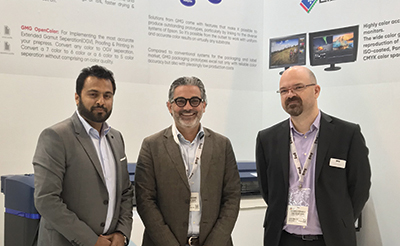The new multi-colour separation software can create a profile with a minimum of 20 patches, Simone Viscomi and Andreas Stephanali of GMG Color tell Benjamin Daniel

L-R: Afsal Kottal, Phoenix Technologies with
Simone Viscomi and Andreas Stephanali of GMG Color
GMG Color is recognised as a proofing company, right? Yes, not just that. “We want to let everyone know that we are mainly a colour management company,” says Simone Viscomi – channel manager at GMG. “We grow with our main product – GMG ColorProof. We implement a lot of products in colour management every year and that’s our main focus.”
But that’s not all. The company is now moving towards a new vertical, and into the realm of digital. OpenColor, a multi-colour separation software developed by GMG, is mostly used in the packaging business where packaging printers can reduce their colours from eight to six.
Viscomi explains, “It enables accurate proof simulation of the overprinting effects of spot colors using special multichannel profiles and spectral data calculation.” He adds, “The difference is that we use spectral data while others use LAB values. With the spectral data technology we use the Esmaltes’s chart where normally others use a Brickster chart, where with a minimum of 20 patches you can make a profile.”
A spectral data system
The OpenColor system is based on a new technology called the spectral data. It no longer use the LAB values but the spectral data to calculate the profiles, which contains much more information. The secret recipe here is the prediction engine behind the open colour profiles.
OpenColor is patented, and was developed by scientists in GMG. “Here a customer can literally play with the proofer as if it’s a real printing press,” says Andreas Stephanali, technical personnel at GMG. “This saves a lot of time. It’s like having a little press in your pre-press facility, and you can use the OpenColor as your proofer.”
Getting the right colour, and consistently, in flexible and corrugation packaging can be a challenge, particularly with primary and secondary packaging. Using the spectral measurements, the ink properties can be better analysed and thus simulated in the proof. The resulting proofs, Stephanali claims, provide a higher accuracy and colour conformance with the final product than comparable proofs of any other profiling and proofing system. “It is our motto that wherever the colour goes, it stays that colour. So we have the technology to align different processes and substrates. We decide on the common colour space and with our software it is possible to compare one colour space to another colour space easily.” OpenColor measures the substance before making the profile.
Profile with minimal patches
Unlike the Brickster chart, OpenColour creates profiles using a minimum of 20 small patches and measures the 20 patches in real production time.
“In the future if the customer changes one colour out of a six-colour process in print, there will be no need to start the process of building the profile all over again. All that is need is, measure the colour that is being added and the system automatically creates a new profile,” says Viscomi. “It’s a big benefit for the customer in terms of saving money.”
GMG has some top players using the OpenColour system. Huhtamaki is one, Kompass in Pakistan is another. There’s a Roto-Gravure cylinder producer in Bangladesh who uses OpenColor. “We have several users. A lot of discussion is going on with customers like Majan Printing and many other prominent packaging printers here in the region. So that will be our main direction from now on,” concludes Viscomi.



